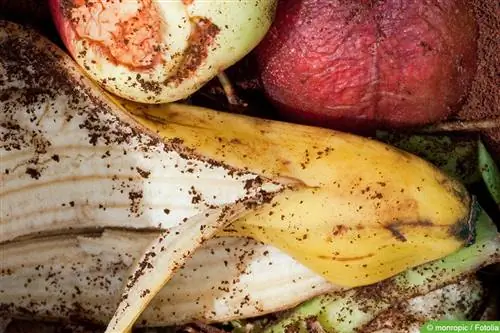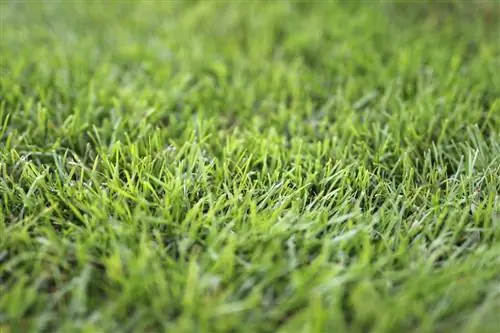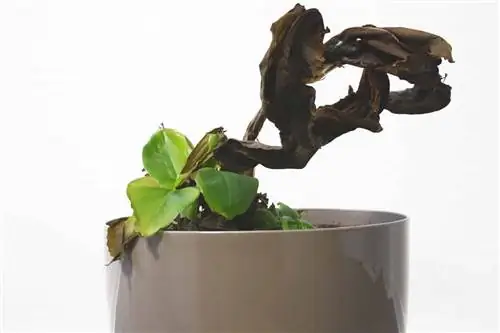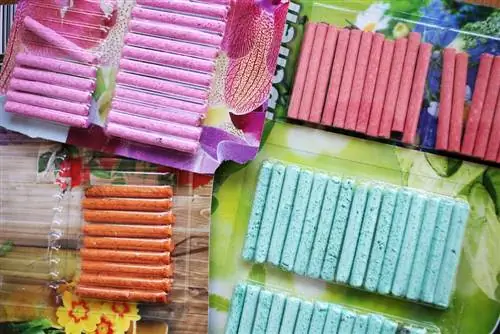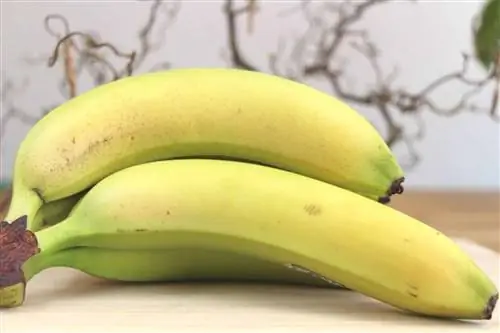- Author admin [email protected].
- Public 2023-12-17 03:39.
- Last modified 2025-01-24 12:45.
The benefits of banana peels for the garden cannot be denied, both in solid and powder form. Over-fertilization is hardly possible. However, not all bowls are suitable.
Application options for fertilizing
Banana peels are not suitable as the sole, complete garden fertilizer because nitrogen and phosphorus are missing. Nevertheless, they can enrich the garden soil. They rot quickly in the soil and release potassium, magnesium, phosphate, sulfur, sodium and silicic acid as well as other minerals and trace elements. This natural fertilizer can be used in different ways.
As dried shell pieces
Even if banana peels are not a complete fertilizer, they are a good replacement for conventional magnesium and potassium fertilizers. It's best to cut the peels into small pieces while they are still fresh. When dried, this is a little more difficult because they are often very fibrous, which could make chopping them more difficult.
- cut or chop fresh peel into pieces
- spread out on a grid, cotton cloth or similar surface
- let it dry completely in a warm, airy place
- Turn several times while drying
- Avoid moisture could cause mold formation
- store dried peels in a sealable container
- collect until you have the amount you need
- Work shallowly into the root area for fertilizing
- ideally in spring as a long-term fertilizer
- Bowls should not stick out of the ground
This fertilizer is easy to make and can be made in advance. The dried pieces must be covered with soil and completely rotted before the next fertilization. The smaller the pieces of shell, the faster they rot.
Tip:
Remaining dried banana peels can also be added to the compost and thus indirectly serve as fertilizer. However, here it only works in a weaker form via humus and not directly on the plant.
As powder
Another way to use the banana or peel as fertilizer is in powder form. To do this, the peels are chopped into fine pieces or directly in the blender. Then spread the whole thing out on a cloth to dry. After a few days, the mixed mass has become a dry, crumbly and brownish powder. The powder can also be made in advance. Until the amount required for fertilization is reached, the powder that has already been produced can be stored in paper bags or cloth bags. The application is similar to that of dried coarser pieces of peel.
For mulching
Banana peels are also very suitable for mulching, especially young plants and seedlings. At the same time, they take on the function of a long-term fertilizer. When drying, you should be careful not to cut them too small, as they will shrink a lot as they dry.
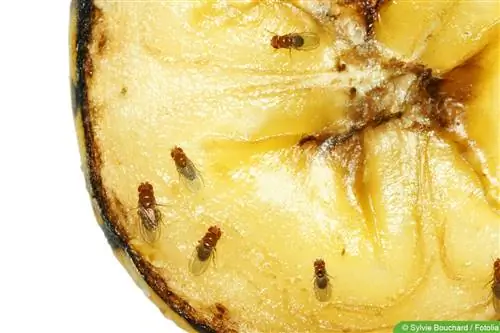
Because they turn brown when dry, they are hardly recognizable on the bed afterwards. To use the dried shell pieces as mulch, you mix them with grass clippings, dry leaves or conventional bark mulch. This means you don't need too many banana peels.
Use only organic bananas
- generally all banana peels can be used
- recommended but only organic banana peels
- It is better to avoid fruits from conventional cultivation
- usually treated with pesticides or anti-mold agents
- are sprayed sometimes weekly and over large areas
- usually until shortly before the harvest
- are intended to protect plants from diseases
- also preserve the shells
- decompose much more slowly in the soil
- unlike organic bananas
The garden soil is more or less heavily polluted by these fungicides. They can also be absorbed by successor cultures. Ideally, you only use banana peels with the Fairtrade seal.
These plants benefit
This fertilizer makes the plants in question he althier and more flowery and, thanks to the high potassium content, they are also well prepared for the cold season. Roses and flowering perennials such as geraniums and fuchsias respond particularly well to this fertilizer. Potassium strengthens plants and at the same time improves their moisture balance and winter hardiness. For the plants mentioned, a combination with nitrogen-containing fertilizers is recommended.
Even orchids, which are known to be very sensitive, can be fertilized with banana peels. Don't forget vegetable plants, because they can also benefit. These include tomatoes, which, as heavy eaters, have high nutrient requirements. Zucchini, pumpkin, cucumbers, parsnips and carrots also enjoy an extra portion of nutrients.

